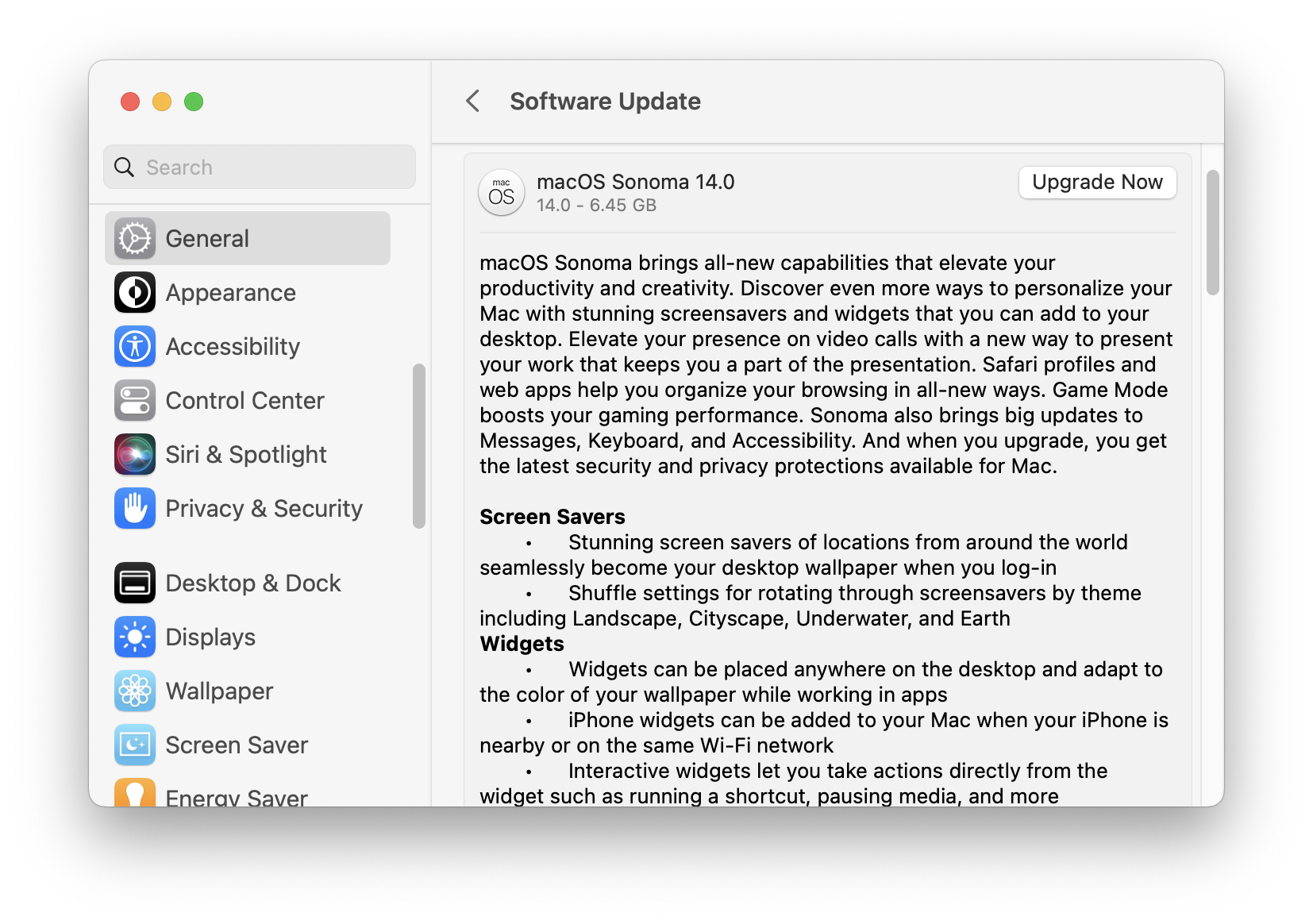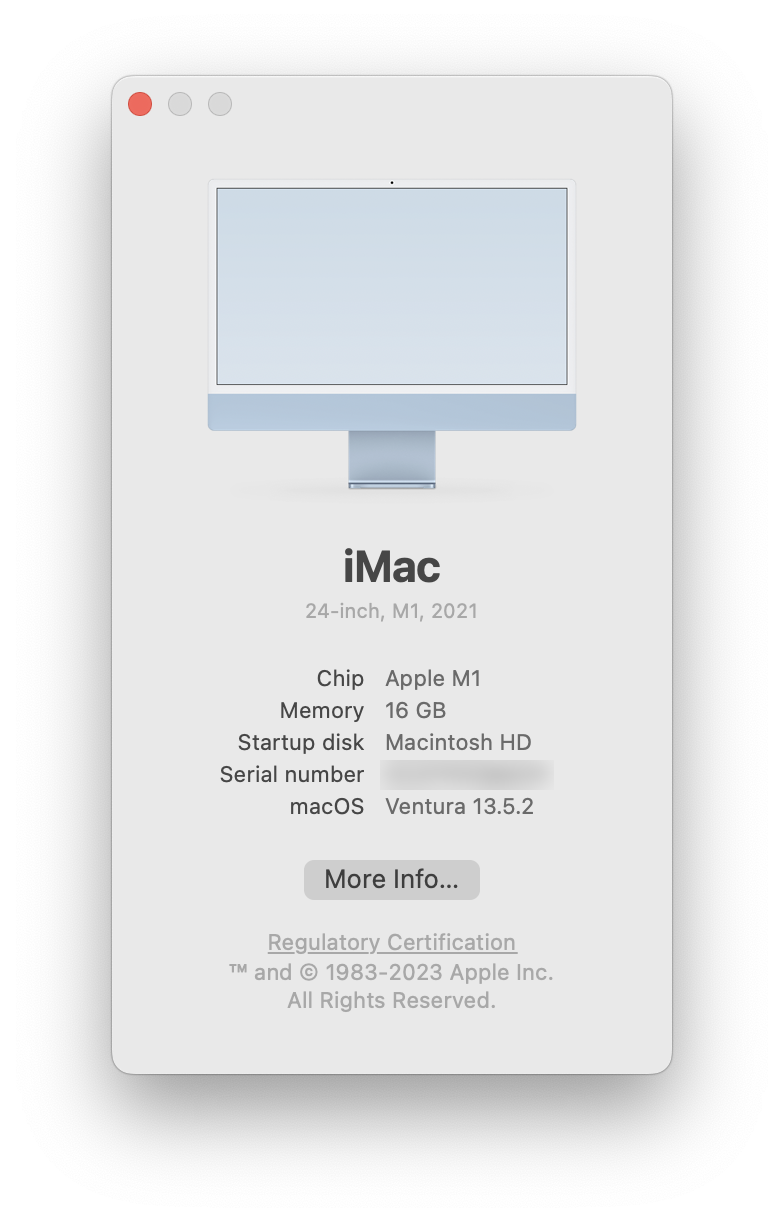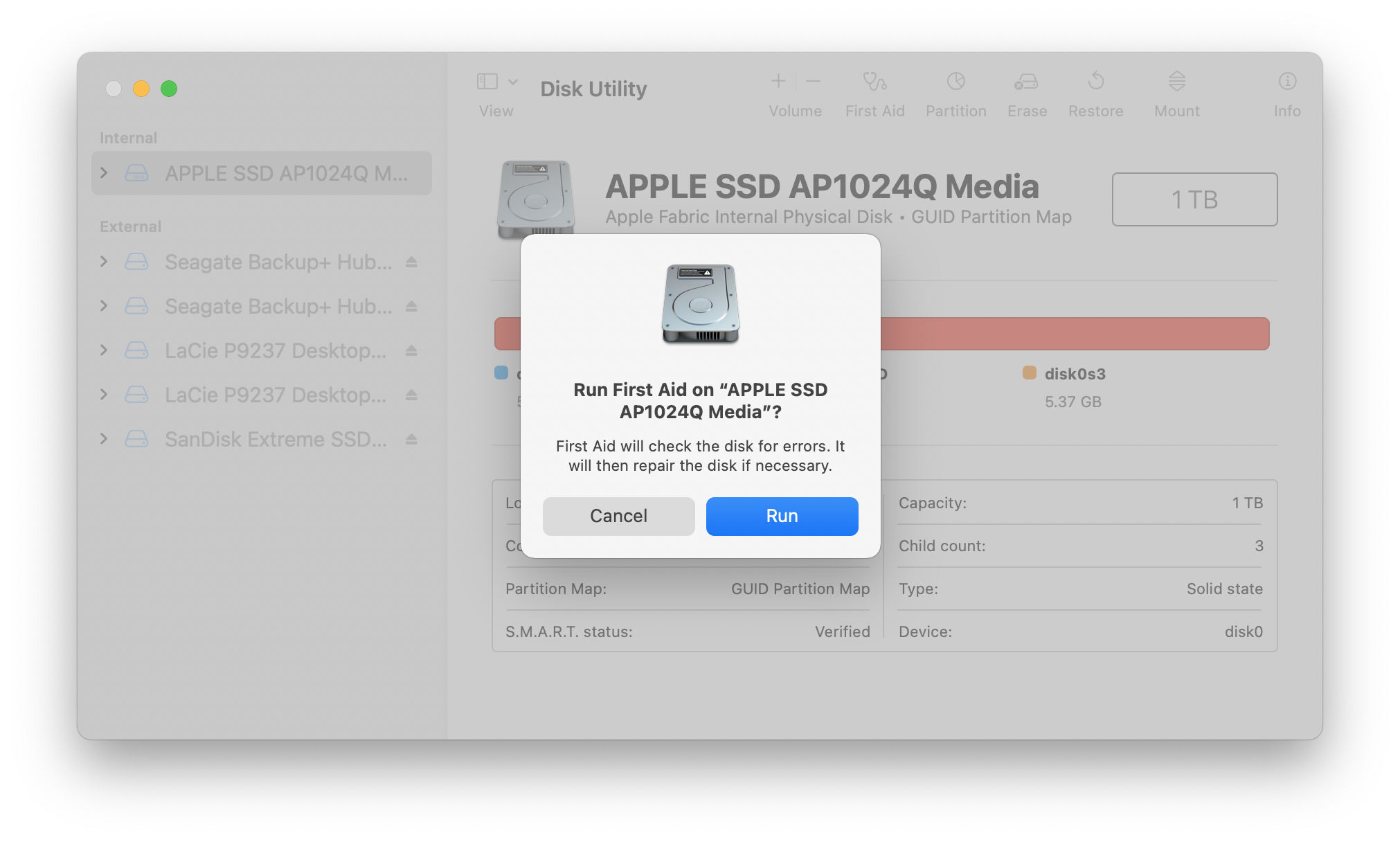How to Prepare Your Mac to Upgrade to macOS Sonoma: the Ultimate Guide
Posted on
by
Kirk McElhearn
![]()
macOS Sonoma, a solid update with plenty of new features that improve productivity and enhance privacy, is available on September 26. While not everyone will want to upgrade to the new operating system, if you plan to do so, then you should prepare your Mac.
Should you upgrade your Mac to Sonoma? Is your Mac compatible with the new operating system? And how should you prepare for this big change? In this article, I’ll answer all those questions, so you can be ready to upgrade your Mac to macOS Sonoma.
Upgrade now, or upgrade later?
If you’re reading this shortly after macOS Sonoma’s initial public release, you should be aware that it’s likely that a few bugs and compatibility issues will be discovered and fixed soon, although these bugs may not necessarily affect you.

Note that, since 2023, Apple has made beta versions of its operating systems available to anyone, regardless of whether they have an Apple Developer account. So even before the release of a new operating system, you can choose to install beta versions. Most people probably should not do this, but if you do want the latest operating system before it’s released, you can do so. See our article How to Install Apple Beta Software for macOS Sonoma, iOS 17, iPadOS 17, watchOS 10, and tvOS 10 for more on using beta software.
Some Mac users, however, prefer to wait a few weeks for the initial bugs to be worked out and patched, and for more information to become available about compatibility with third-party apps and hardware, before upgrading to the latest macOS.
You should also consider that the latest macOS version is generally the safest to use online. Major new macOS versions typically contain security enhancements and fix vulnerabilities that never get fixed for the previous macOS versions.
Regardless of whether you prefer to upgrade immediately or wait a few weeks first – or if you haven’t yet decided which category you fall into – read this guide carefully to make sure you’ve made all the important considerations before taking the leap into the next-generation Mac operating system.
Mac Model Compatibility
The first thing to check is whether your Mac is compatible with Sonoma. The following Macs can run macOS Sonoma:
- iMac (2019 and later)
- iMac Pro (2017 and later)
- Mac Mini (2018 and later)
- Mac Pro (2019 and later)
- MacBook Air (2018 and later)
- MacBook Pro (2018 and later)
This isn’t a big change from the devices compatible with macOS Ventura. You could install Ventura on 2017 iMacs, and Sonoma requires 2019 iMacs. The MacBook is no longer supported, and MacBooks Pro are supported from 2018 instead of 2017.
If you’re not sure of the vintage of your Mac, go to the Apple menu, and choose About This Mac. You’ll see its model and year.

Compatibility of security software and hardware drivers
If you care about your security and privacy, you probably use software such as an antivirus or firewall (including Intego software), or VPN software. It’s always important to upgrade these to the latest versions before you upgrade to a major new macOS release. Intego’s apps are already fully compatible with macOS Sonoma. Be sure to run NetUpdate to verify that you have the latest versions.
It’s also very important to check that any hardware drivers you rely on are compatible. For example, if you use a RAID storage device, and its driver isn’t updated, you won’t be able to access your files on that device; and if you have a graphics card whose drivers are not part of macOS, you’ll need to make sure they have been updated to use your Mac correctly.
You may also want to verify that there are Sonoma compatible drivers for your printer or any other hardware that may rely on custom software for special features. Although some printers, scanners, and other common hardware may work fine without any custom software, you may not know for sure about your own peripherals until you try them with Sonoma.
Compatibility of Apple and third-party software
Any software that’s actively developed by Apple should be fully compatible with macOS Sonoma by the time of its release. Many major third-party apps will work as well, but there’s a possibility that one or more apps that you depend on won’t be, especially older apps that may no longer be updated.
In some cases, third-party app developers might not yet have finished developing a Sonoma compatible version, and in rare cases it may not be possible to make their apps compatible. If there are any apps you can’t live without, it is essential that you check to make sure that your apps are compatible. Imagine if you don’t, and you find that one app you use to perform an important task for your clients doesn’t work! You might be forced to rely on your system backup (more on that below) and try to revert back to Ventura.
Apple does not maintain a list of compatible third-party apps. Each app developer should say on their website, or in Mac App Store information, whether they are compatible. But in some cases, especially for older or infrequently updated apps, you may not know unless you contact the developer.
Clean your Mac
The full macOS Sonoma installer is about 12 GB, and the upgrade via Software Update is about 6.5 GB. It’s safe to assume that you need at least the double of that size to perform the upgrade. I’d say that you should have at least 25 GB free on your Mac regardless of the method. You may need to offload some files to an external drive in order to have enough space. The ideal candidates for this are videos and virtual machines (if you use software like Parallels Desktop or VMware Fusion to run other operating systems on your Mac).
If you back up your Mac to an external drive – which is something you should do regularly – you should still copy any files you temporarily remove from your Mac to another drive, just in case there is a problem with your backup.
There may also be lots of gunk on your Mac that you don’t need. You can check this by choosing the Apple menu > About this Mac, then clicking on Storage, then click More Info, then scroll down and click Storage Settings. You’ll see how much space each type of files takes up, and see some options to remove files. If you try out lots of software, you might want to look at your Applications folder; you may find a number of apps you can delete, that can free up several gigabytes of data. For each of the categories, click the ⓘ (circled letter “i”) icon to see which files take up the most space.
Related: How to Clean Out Disk Space on Your Mac in macOS Sonoma
You can also use Intego Washing Machine (available as part of Mac Premium Bundle X9, Mac Washing Machine Secure X9, or standalone) to clean up and delete files you no longer need, such as cache files, downloads, duplicates, and more.
Update other software
It’s a good idea to update as much of your software as possible before upgrading to a new Mac operating system, because in many cases updates will be available that are compatible with the new operating system before its release.
Most apps these days offer automatic update features, or, if you’ve purchased them from the Mac App Store, you can get updates via the App Store app. Updating is especially important for software like the Microsoft Office suite, the Adobe Creative Cloud apps, or other apps you may depend on for your work.
Check your drive
Apple’s Disk Utility (located in /Applications/Utilities) is a tool designed to manage disks, but also to check them for errors. Before upgrading, it’s a good idea to run Disk Utility’s First Aid tool on your startup volume, as well as on the disk(s) you will use to back up your Mac (see below).
Launch Disk Utility, select your startup volume, then click First Aid in the toolbar. This will take a few minutes, and during the process your disk will be locked so Disk Utility can make repairs, if necessary. When this is completed, it will tell you if all is well, and if it has made repairs.

Back up your Mac
If your Mac is compatible, and you’re ready to upgrade, the next thing you should do is back up your Mac. You can use Time Machine if you have an external hard drive, but the safest way to do this is to clone your drive. A clone, or bootable backup, is an exact copy of everything on your Mac’s drive: system files and personal data. You can do this with Intego Personal Backup.
Related:
If anything goes wrong during the upgrade process, you can boot from the external drive, and, if necessary, recopy all its files to your Mac.
And, of course, you can always take a belt-and-suspenders approach and do both. That way if something goes wrong with restoring a backup, you can feel secure knowing that you have an alternative option.
One more thing: It’s a good idea to actually test your backups to ensure that they’re working correctly. A backup isn’t very useful unless you can actually restore from it.
Choose an upgrade method: Migration or Clean Installation
There are two ways to upgrade a Mac. The simplest is to run the macOS Sonoma installer, or install the update from the Software Update pane of System Settings. Both of these methods install the new files over your existing operating system. They don’t alter your personal data, but only those files that are part of the system, as well as bundled Apple apps.
The other is to perform a clean installation, setting up your Mac with the new operating system, then copying files from the previous operating system. To do this, you should clone your Mac, on at least two drives (one to use for the upgrade, and another as a backup). Start up your Mac, then, if you have an Intel processor in your Mac, press the Option key immediately so you can select a cloned drive as the startup drive. For M1 Macs, press and hold the power button until you see Loading Startup Options, then choose the external drive. Launch Disk Utility (in /Applications/Utilities) and erase the drive on your Mac. (You did make two backups, right?)
Download the macOS Sonoma installer and launch it. It will ask which drive you want to install the software on; select the now erased drive in your Mac. Follow the instructions to complete the installation.
When you’ve finished, you’ll have a virgin operating system on your Mac, and you’ll still be working from your external drive. You can now copy all the files in your home folder, as well as personal apps.
Related:
How to Set Up a New Mac: Should You Migrate or Do a Clean Installation?
A clean installation is time consuming, but it can weed out old files from apps you no longer use, and it’s a good way to start with a clean slate. Some people do this for every major operating system upgrade; I only do it every few years, because it does take a long time. If you do a clean installation, make sure to keep both of your clones for some time, just in case there’s something you forgot to copy over.
How to install macOS Sonoma
Okay, it’s taken a while, but now you’re ready. If you’re installing macOS Sonoma on a laptop, make sure it’s charged, or connect it to a power supply; you don’t want it running out of battery during the installation process.
There are two ways to install macOS. The first is to go to the Mac App Store and download the macOS Sonoma installer. This installer is around 12 GB in size, so it may take a while to download, depending on your bandwidth. When the download is complete, the installer will launch; follow its instructions. The upgrade process can take a while – expect it to take a half-hour or more – and this is a good time to get a cup of tea or coffee, walk the dog, or do something else instead of sitting in front of your Mac watching its progress bar.
The second, and easier method, is to go to System Settings > General > Software Update. You’ll see the option to install macOS Sonoma here. As mentioned above, you’ll also see an option to install beta software, but think carefully before you do this, because beta software can be unstable.
Before you start the upgrade, you should be aware that after macOS is installed, if you downloaded it from the Mac App Store, the installer is usually deleted automatically. If you look in your Applications folder before starting the upgrade, you’ll see the installer app, called Install macOS Sonoma. It’s a good idea to make a backup copy of this app in another location: an external drive, or perhaps your Downloads folder. This can be handy in case something goes wrong and you need to run it again. This is also useful if you have more than one Mac and want to avoid having to wait to download the Sonoma installer again; you can just copy the installer app to another Mac and run it.
Once the installation is complete, you need to go through a few screens, such as one to sign into your iCloud account. At this point, you may see an Incompatible Software screen telling you of apps that have been moved because they are known to be incompatible. You’ll find them in an Incompatible Software folder at the top level of your drive.
What to do if something goes wrong
Many things can go wrong with an operating system upgrade. If you have a problem, you can boot your Mac from the clone you made earlier, then run the installer again. In a worst-case scenario, you may need to wipe your Mac’s startup drive, then follow the clean installation method I discussed above.
Even if all seems well, keep your clone or backup for a while, just in case something goes wrong within the first few days or so. You can start checking out some of the new features in macOS Sonoma.
How can I learn more?
 Each week on the Intego Mac Podcast, Intego’s Mac security experts discuss the latest Apple news, security and privacy stories, and offer practical advice on getting the most out of your Apple devices. Be sure to follow the podcast to make sure you don’t miss any episodes.
Each week on the Intego Mac Podcast, Intego’s Mac security experts discuss the latest Apple news, security and privacy stories, and offer practical advice on getting the most out of your Apple devices. Be sure to follow the podcast to make sure you don’t miss any episodes.
You can also subscribe to our e-mail newsletter and keep an eye here on The Mac Security Blog for the latest Apple security and privacy news. And don’t forget to follow Intego on your favorite social media channels: ![]()
![]()
![]()
![]()
![]()
![]()
![]()